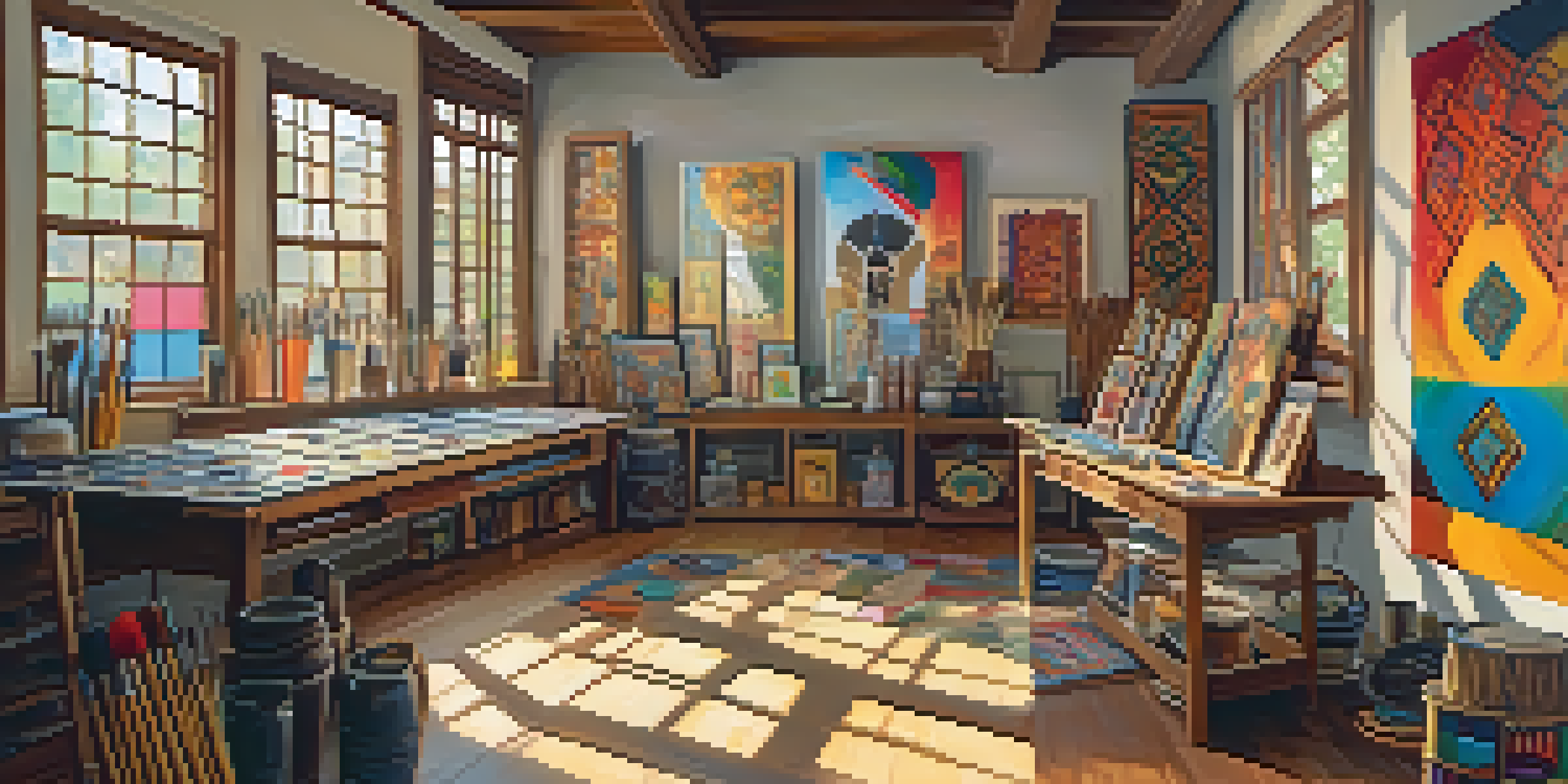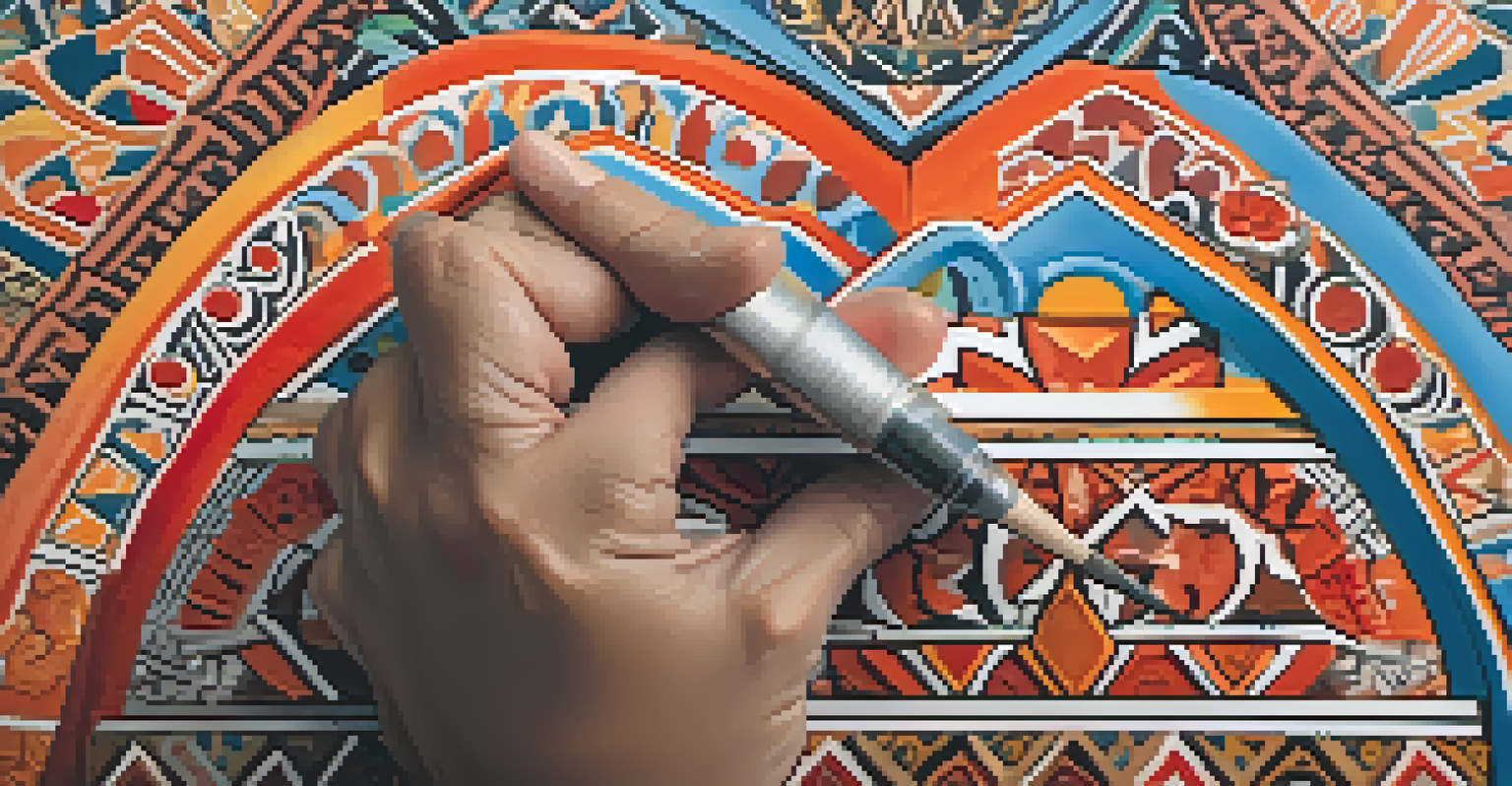Historical Context of Cultural Appropriation in Painting

Understanding Cultural Appropriation in Art
Cultural appropriation in art refers to the adoption of elements from one culture by members of another, often without permission. This can be seen in painting when artists borrow styles, symbols, or themes from cultures not their own. While some argue that this exchange fosters creativity, others caution against its potential to exploit marginalized cultures.
Cultural appropriation is not just a matter of borrowing. It is about the relationships of power and the historical context in which borrowing occurs.
The nuances of cultural appropriation hinge on power dynamics and historical context. For instance, when a dominant culture appropriates from a marginalized one, it can erase the original meaning and significance attached to those cultural elements. This dynamic is crucial to understanding the broader implications within the art world.
In painting, appropriation can lead to a rich dialogue between cultures, but it can also raise ethical concerns. Artists and audiences alike must consider the line between appreciation and appropriation, ensuring that cultural exchanges are respectful and informed rather than superficial.
Historical Examples of Cultural Appropriation in Painting
Throughout history, various artists have appropriated elements from different cultures, often leading to controversy. For example, the use of African motifs in the works of European modernists like Picasso sparked debate about authenticity and respect. Such instances highlight the fine line between inspiration and exploitation.

Another notable example is the use of Indigenous themes in American art during the late 19th and early 20th centuries. Many artists romanticized Native American culture, often stripping away its complexities and reducing it to mere aesthetic choices. This not only misrepresented Indigenous cultures but also contributed to their commodification.
Cultural Appropriation Explained
Cultural appropriation in art involves adopting elements from one culture by another, often raising ethical concerns about respect and power dynamics.
These historical instances illustrate that cultural appropriation in painting is not a new phenomenon. Instead, it has evolved over centuries, prompting ongoing discussions about ethics in the art world and the responsibilities of artists when engaging with cultures outside their own.
The Role of Colonialism in Cultural Appropriation
Colonialism has played a significant role in shaping the dynamics of cultural appropriation in art. As European powers colonized various regions, they often appropriated local art forms and traditions, stripping them of their original meanings. This process not only affected the cultures being appropriated but also influenced the development of Western art.
Art is a collaboration between cultures, and it should be approached with respect and understanding, not exploitation.
The impact of colonialism can be seen in how Western artists adopted and adapted Indigenous art styles, often without acknowledging their origins. This practice raises questions about ownership and the power imbalances inherent in the art world. It serves as a reminder of the lasting effects of colonialism on cultural exchange.
Understanding this historical context is essential for contemporary artists. It encourages them to engage thoughtfully with the cultures they draw inspiration from, fostering a more equitable and respectful dialogue between diverse artistic traditions.
Contemporary Perspectives on Cultural Appropriation
In recent years, cultural appropriation has become a hot topic in the art community, with many artists and critics advocating for more awareness and sensitivity. Contemporary artists are increasingly challenged to navigate the complexities of cultural borrowing, often facing backlash for perceived insensitivity. This dialogue is crucial as it pushes artists to reflect on their practices and intentions.
Many contemporary artists actively seek to collaborate with members of the cultures they wish to represent. This approach not only enriches their work but also helps to dismantle the power structures that often accompany appropriation. By fostering genuine connections, they create a space for mutual respect and understanding.
Historical Context Matters
Understanding the historical context of cultural appropriation, particularly the impact of colonialism, is crucial for contemporary artists to foster respectful cultural exchanges.
Moreover, art institutions are beginning to recognize the importance of addressing cultural appropriation in their practices. Exhibitions and programs now often include discussions about the implications of borrowing and the importance of representation, emphasizing the need for a more inclusive art world.
Navigating Cultural Sensitivity in Artistic Practices
Navigating cultural sensitivity in painting requires artists to engage deeply with the cultures they draw inspiration from. This involves conducting thorough research and understanding the historical significance of the elements they wish to incorporate. Artists who take the time to learn about the cultures they reference are more likely to avoid appropriation and foster genuine appreciation.
Additionally, collaborating with cultural representatives can provide valuable insights and perspectives that enhance artistic integrity. By involving community members in the creative process, artists can ensure that their work is respectful and accurately reflects the nuances of the culture. This collaborative approach strengthens the relationship between artists and the communities they engage with.
Ultimately, being culturally sensitive in painting is about acknowledging the stories and histories behind the art. It encourages artists to be mindful of their impact and to create works that honor rather than exploit cultural traditions.
The Impact of Social Media on Cultural Appropriation Discussions
Social media has transformed the way cultural appropriation is discussed and critiqued in the art world. Platforms like Instagram and Twitter allow artists and audiences to share their opinions and experiences instantly. This democratization of conversation empowers marginalized voices, urging artists to be more accountable for their creative choices.
Online discussions often bring attention to specific examples of appropriation, prompting public debates that can influence an artist's reputation and career. Artists are increasingly aware of how their work is perceived in the digital landscape, leading to a heightened sensitivity towards cultural issues. This awareness can lead to more thoughtful and responsible artistic practices.
Social Media's Role in Dialogue
Social media has transformed discussions on cultural appropriation, empowering marginalized voices and encouraging artists to be more accountable for their creative choices.
Moreover, social media serves as a platform for education, where artists can learn from each other about cultural appropriation and its implications. It fosters a community of dialogue, encouraging artists to share resources and insights, ultimately promoting a more respectful approach to cultural exchange.
Future Directions in Cultural Appropriation and Art
As discussions around cultural appropriation continue to evolve, the future of art may see a shift toward more collaborative and inclusive practices. Artists are increasingly recognizing the value of authentic representation and the importance of engaging with cultures in a meaningful way. This shift could redefine how art is created and appreciated across various cultural contexts.
Future artists may prioritize ethical considerations in their work, ensuring that their artistic expressions are not only inspired but also respectful. This could lead to the development of new art forms that celebrate cultural diversity while fostering mutual understanding. The emphasis will likely be on collaboration rather than appropriation.

Ultimately, the future of cultural appropriation in painting hinges on ongoing dialogue and education. By continuing to engage with these issues, artists and audiences can work together to create a more inclusive and respectful art world, where cultural exchange is celebrated rather than exploited.